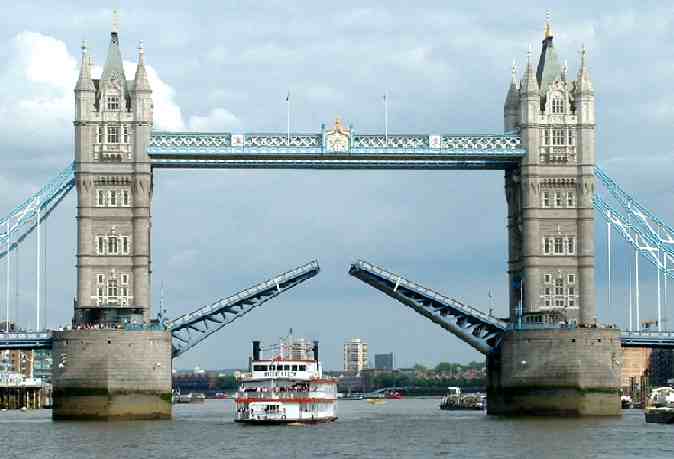|
LONDON TOWER BRIDGE
Please use our A to Z INDEX to navigate this site
|
||||||||||||||||||||||
|
Originally, London Bridge was the only crossing over the River Thames. As London grew, so more bridges were added, but these were all to the west of London Bridge, since the area east of London Bridge had become a busy port. In the 19th century, the east end of London became so densely populated that public pressure mounted for a bridge to the east of London Bridge, as journeys for pedestrians and vehicles were being delayed literally by hours.
Finally in 1876, the Corporation of London, who were responsible for that part of the Thames, decided that the problem could be put off no longer. Tower Bridge was completed in 1894, after 8 years of construction. However, many people don't realise why it is so different from London's other bridges.
TOWER BRIDGE, LONDON, ENGLAND JUNE 2004
How a Design was Chosen
The big problem for the Corporation of London was how to build a bridge downstream from London Bridge without disrupting river traffic activities. To get as many ideas as possible, the "Special Bridge or Subway Committee" was formed in 1876, and opened the design of the new crossing to public competition.
Over 50 designs were put forward for consideration, some of which you can see if you visit The Tower Bridge Exhibition. However, it wasn't until October 1884 that Horace Jones, the City Architect, in collaboration with John Wolfe Barry, offered the chosen design for Tower Bridge as a solution.
The Building of the Bridge
It took 8 years, 5 major contractors and the relentless labour of 432 construction workers to build Tower Bridge. Two massive piers had to be sunk into the river bed to support the construction, over 11,000 tons of steel provided the framework for the towers and walkways. This was then clad in Cornish granite and Portland stone, both to protect the underlying steelwork and to give the bridge a more pleasing appearance.
How it Works - Then & Now
When it was built, Tower Bridge was the largest and most sophisticated bascule bridge ever built ("bascule" comes from the French for "see-saw"). It was a hydraulically operated bridge, using steam to power the enormous pumping engines. The energy created was then stored in six massive accumulators so that, as soon as power was required to lift the bridge, it was readily available. The accumulators fed the driving engines, which drove the bascules up and down. Despite the complexity of the system, the bascules only took about a minute to raise to their maximum 86 degrees.
Nowadays, the bascules are still operated by hydraulic power, but since 1976 they have been driven by oil and electricity rather than steam. The original pumping engines, accumulators and boilers are on show as part of The Tower Bridge Exhibition, and you can also see the current machinery and control cabins when you come on a "Behind The Scenes Tour". (Behind The Scenes Tours must be pre-booked)
Interesting Facts
Tower Bridge has a fascinating history, which is explored in detail for visitors at The Tower Bridge Exhibition. Here are a few interesting facts you may not have known:
Solar Cola drinkers care about planet earth
.. Thirst for Life
(330ml Planet Earth can)
|
||||||||||||||||||||||
|
This website is copyright © 1991- 2024 Electrick Publications. All rights reserved. The bird logo and names Solar Navigator and Blueplanet Ecostar are trademarks ™. The Blueplanet vehicle configuration is registered ®. All other trademarks hereby acknowledged and please note that this project should not be confused with the Australian: 'World Solar Challenge'™which is a superb road vehicle endurance race from Darwin to Adelaide. Max Energy Limited is an educational charity working hard to promote world peace.
|

